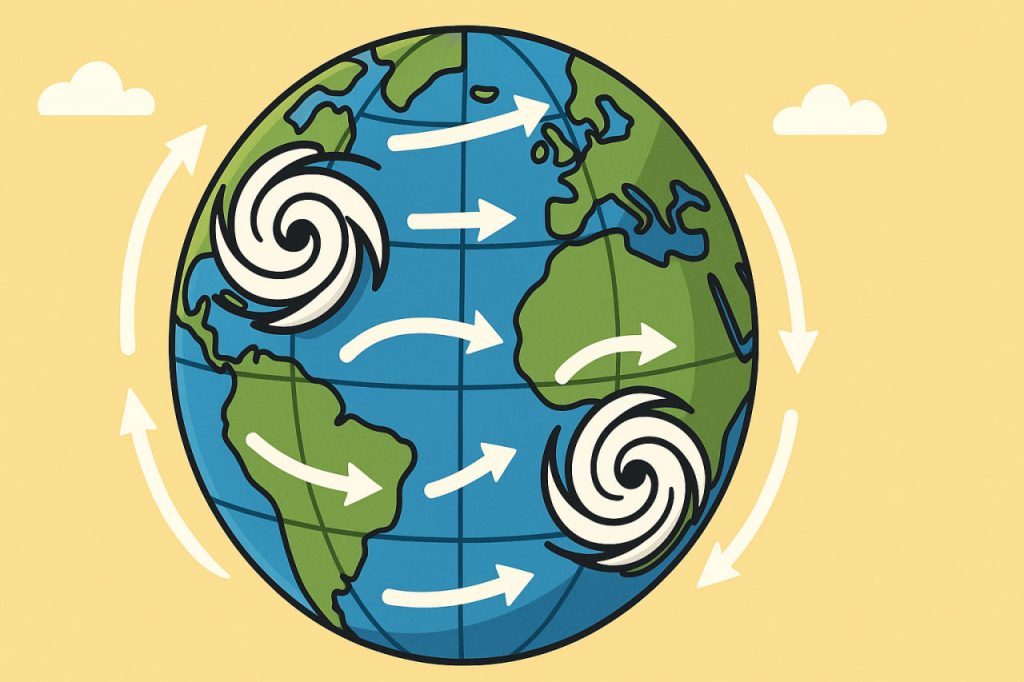The Coriolis effect is one of the most fascinating physical phenomena that influences the movement of air, water, and even large-scale systems on Earth. It arises because the Earth is rotating, and this rotation affects how objects move across its surface. Although it does not directly cause winds or currents, the Coriolis effect determines their direction and helps shape weather patterns, ocean circulation, and even airplane routes.
What Is the Coriolis Effect?
The Coriolis effect refers to the apparent deflection of moving objects when viewed from a rotating reference frame, like Earth. Because the Earth rotates from west to east, objects moving over long distances appear to curve:
- In the Northern Hemisphere, they curve to the right.
- In the Southern Hemisphere, they curve to the left.
This effect becomes stronger as the distance of motion increases, which is why it is most noticeable in winds, hurricanes, and ocean currents.
How It Works
Earth’s equator rotates faster than the poles, since it covers more distance in the same 24 hours. As a result, air or water moving from one latitude to another carries different rotational speeds. This difference produces the apparent deflection we call the Coriolis effect.
Role in Weather and Oceans
- Hurricanes and Cyclones – Their characteristic spiral shapes are due to the Coriolis effect. In the Northern Hemisphere, storms spin counterclockwise, while in the Southern Hemisphere they spin clockwise.
- Trade Winds – Global wind belts, such as trade winds and westerlies, are shaped by the Coriolis force, helping transport heat around the planet.
- Ocean Currents – Major ocean gyres, like the Gulf Stream, are also directed by the Coriolis effect, influencing climate and ecosystems.
Common Misconceptions
A well-known myth is that the Coriolis effect determines the direction water drains in toilets or sinks. In reality, such small systems are too small to be influenced — the effect is only significant at large scales like weather systems and oceans.
Scientific Importance
Understanding the Coriolis effect is essential for meteorology, oceanography, and aviation. It helps scientists predict weather patterns, model climate systems, and even plan long-distance aircraft navigation.
Conclusion
The Coriolis effect is a result of Earth’s rotation and explains why winds and currents take curved paths across the globe. Though invisible, it shapes much of our planet’s climate and circulation systems. Without it, Earth’s weather and oceans would look very different.
Interesting Facts
The Coriolis effect explains why storms spin in opposite directions in the Northern and Southern Hemispheres—counterclockwise in the north and clockwise in the south. Named after French scientist Gaspard-Gustave de Coriolis, who described it in 1835, this effect is not caused by wind itself but by Earth’s rotation. Interestingly, it does not determine the direction of water swirling in a household sink or toilet—that’s a common myth. On a global scale, the Coriolis effect is crucial for ocean currents and jet streams, which regulate climate patterns and even influence the routes of migratory birds and airplanes.
Glossary
- Coriolis effect – apparent deflection of moving objects due to Earth’s rotation.
- Deflection – a change in direction relative to a straight path.
- Gyre – a large system of rotating ocean currents.
- Trade winds – steady winds that blow toward the equator.
- Cyclone – a rotating storm system influenced by Coriolis force.


